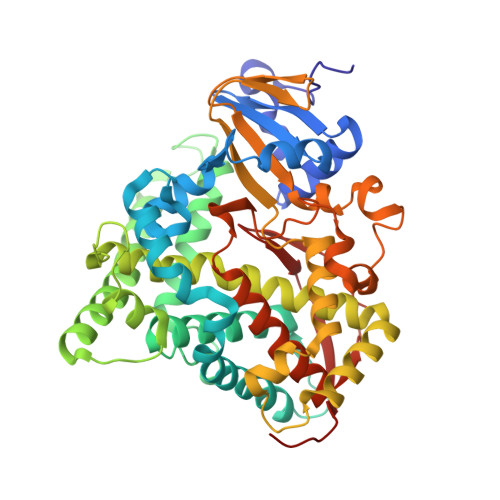Modeling protein-substrate interactions in the heme domain of cytochrome P450(BM-3).
Li, H., Poulos, T.L.(1995) Acta Crystallogr D Biol Crystallogr 51: 21-32
- PubMed: 15299332
- DOI: https://doi.org/10.1107/S0907444994009194
- Primary Citation of Related Structures:
2BMH - PubMed Abstract:
The crystal structure of heme domain of the fatty acid monooxygenase, cytochrome P450(BM-3), consisting of residues 1-455 has been independently solved to R = 0.18 at 2.0 A. The crystal form used, space group P2(1) with two molecules per asymmetric unit, is isomorphous with that form with residues 1-471 first described by Boddupalli et al. [Boddupalli, Hasemann, Ravinchandran, Lu, Goldsmith, Deisenhofer & Peterson (1992). Proc. Natl Acad. Sci. USA, 89, 5567-5571] and used by Ravichandran, Boddupalli, Hasemann, Peterson & Deisenhofer [(1993). Science, 261, 731-736] to determine the crystal structure. The substrate-access channel consists of a large, hydrophobic cleft that appears to be the most likely route taken by fatty acid substrates. Attempts to soak crystals in mother liquor containing a variety of fatty acid substrates yielded featureless difference Fouriers even though fatty acid substrates are known to bind with dissociation constants in the micro M range. Modeling substrate-enzyme interactions reveals few contacts between the enzyme and substrate. More detailed modeling was carried out by subjecting both molecules in the asymmetric unit to extensive energy minimization. These studies reveal that the heme-domain active-site cleft can undergo a large conformational change that closes the access channel thereby providing enhanced protein-substrate interactions. These conformational changes are prevented from occurring by intermolecular contacts in the crystal lattice which lock the protein in the 'open' conformation.
Organizational Affiliation:
Department of Molecular Biology and Biochemistry, University of California at Irvine, 92717, USA.















